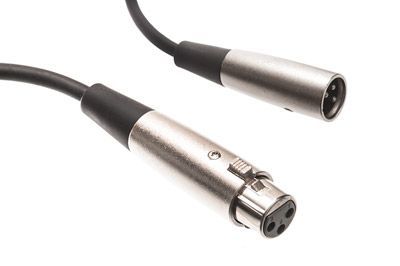DMX Cable - XLR 3 Pin Male to XLR 3 Pin Female
DMX Pro Audio Cable - XLR 3 Pin Male to Female Cable
DMX cables are typically used for lighting applications. DMX 3 pin cables feature high-quality rugged XLR connectors. The cable is made from true 110 ohm cable that minimizes signal reflections for accurate data transfer. Internally this cable is features a hi-density OFC braided shield for superior EMI and RFI rejection. These DMX cables deliver exceptional performance at a budget friendly price.
Features:
- Connector A: XLR 3 Pin Male
- Connector B: XLR 3 Pin Female
- Internal strain relief
- True 110 Ohm
- Hi-density OFC braided shield
- AES/EBU Compatible
Q: What are XLR Cables commonly used for?
A: XLR Connectors are commonly used for professional audio video and stage lighting equipment.
Q: What makes an XLR audio cable and DMX cable different?
A: The XLR audio cable is designed for audio frequencies (low frequencies) and is a low impedance (75 Ohm) high capacitance cable. DMX data cable is designed for a wide bandwidth high frequency data stream it is a higher impedance (110 Ohm) and low capacitance cable. In the DMX system this impedance mismatch can result in intermittent problems due to a distortion of the waveform of the DMX bit stream. You may have flickering LEDs scroller miscue or a twitching moving light. Also some XLR audio cables tie the signal return and shield drain wire differently than we tie the twisted pair return within a DMX cable. This may introduce a potential grounding problem in your system.
Q: What is a balanced cable and what makes them different then an unbalanced cable?
A: Balanced refers to a “three-legged IN type of electrical signal that has two legs independent of ground. One is generally considered positive and the other negative in voltage and current flow with respect to ground. Both legs carry the signal. The benefit is that any noise that gets induced into the line will be common to both the positive and negative sides and is thus canceled when it arrives at its destination assuming the destination is balanced. Balanced lines are generally best for long cable runs due to their ability to reject induced noises. XLR and TRS type cables are designed to transmit balanced audio from one balanced device to another.
Unbalanced cables are less complicated and less expensive but they have limitations. Any audio signal requires two wires or conductors to function. In an unbalanced cable situation one of those conductors is used to carry both the audio signal and ground (shield). Unbalanced cables are much more susceptible to induced noise problems than their balanced counterparts because any induced noise in one conductor is not canceled by similar noise in the other conductor and may be carried with the signal into connected equipment. In general unbalanced lines should be kept as short as possible to minimize potential noise problems.
| Features & Specs | ||
|---|---|---|
| Connector Side A | Connectors on this cable?? | 3 Pin XLR Male |
| Connector Side B | Connectors on this cable? | 3 Pin XLR Female |
| Length | The Length of the cable? | 3ft |
| Use | The use for this cable?? | Lighting |
| Color | The color of the cable? | Black |
| Shielding | The type of shielding?? | Fully shielded |

